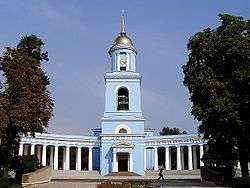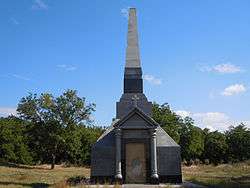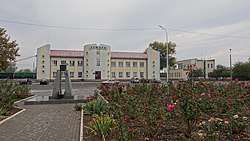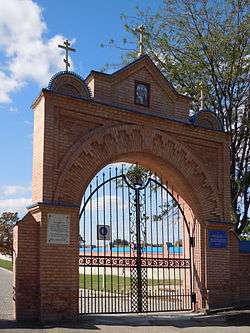Izmail
Izmail (Ukrainian: Ізмаїл) is a historic town near the Danube river in the Odessa Oblast (province) of Southern Ukraine. Serving as the administrative center of the Izmailsky Raion (district), the city is also designated as a separate raion within the oblast.

Understand
Izmail is the largest Ukrainian port on the Danube Delta. As such, it is a center of the food processing industry and a popular regional tourist destination. It is also a base of the Ukrainian Navy and the Ukrainian Sea Guard units operating in Danube. The World Wildlife Fund's Isles of Izmail Regional Landscape Park is located nearby.
The current estimated population is around 85,000, with ethnic Russians forming about 42.7% of that total, 38% being Ukrainians, 10% Bessarabian Bulgarians, and 4.3% Moldovans.
History

The fortress of Izmail was built by Genoese merchants in the 12th century. The town was first mentioned under the name Ismailiye, derived from name of an Ottoman Empire Grand Vizier Izmail. From the end of the 14th century, Izmail was under the rule of Moldavia, but it was later reconquered by the Ottomans, and became a protectorate until Russian general Nicholas Repnin took the fortress in 1770, it was heavily refortified, so as never to be captured again. The Sultan boasted that the fortress was impregnable, but during the Russo-Turkish War of 1787-1792 the Russian Army commander Alexander Suvorov successfully stormed it, an achievement hailed in the country's first national anthem, "Let the thunder of victory sound!" After the assault nearly every Muslim man, woman, and child in the city had been killed in the three days of uncontrolled massacre, 40,000 Turks dead, a few hundred taken into captivity.
At the end of the war, Izmail was returned to the Ottoman Empire, only to be returned to Russia along with the rest of Bessarabia in the 1812 Treaty of Bucharest. But Russia was then forced to secede to Moldavia, After Russia lost the Crimean War. During World War II, it was again occupied by the Soviet Red Army and included in the Ukrainian SSR. Since 1991, Izmail has been part of independent Ukraine.
Get in
By plane
Izmail airport (IZL IATA) ceased its operation in 2009. Nearest international airports are in Odessa and Chisinau (Moldova).
By train

Izmail train terminal is 2.5 km northwest of downtown. Follow Suvorova Av. and Lenina Av (2.5 km) or take buses/minibuses (#10, #16, #18, #24). Information: +38 (4841) 9-42-19, 5-71-10. Despite moribund passenger connections, the train station is fully operational and open 24/7. It features a big waiting lounge and even a hostel. The single train #686 connects Izmail to Odessa (via Bilhorod-Dnistrovskyi), with the travel time of 6½ hours. Depending on the season, this train may run either during the day or overnight, but it mostly consists of sleeping cars anyway. A seat car is also available, though. It is a dirt cheap travel option that costs 18 hr (2012), only. Take the train when you want to enjoy the scenery. Otherwise, buses will easily save you 2–3 hours and offer a more convenient schedule.
By bus
Izmail bus station is on 70 Pushkina St. close to the central market. Information: +38 (4841) 2-02-02, cash desk: 2-65-79. This bus station mostly caters to normal (big) buses, whereas locals prefer to use minibuses, which are more chaotic and meander around the city to pick up or drop passengers. Unless booked in advance, these minibuses will usually stop at the city center, next to Suvorov Museum at 37 Suvorova Av. (this place is colloquially known as ryadom s zagsom).
Most buses connect Izmail to Odessa (Central Bus Station). Travel time is 4–5 hours for normal buses and about 3½ hours for minibuses. Both operate with 1–1½ hour intervals. Being agile enough, you can see Izmail in one day and return to Odessa in the evening. See here for a tentative schedule of minibuses. Normally, it is possible to come to the bus station and catch the soonest bus or minibus. When you want to secure your place and check the schedule, inquire by phone: +38 (4841) 6-51-20, 2-33-35, 2-67-19, 2-14-48, 6-37-80 for different minibus operators, or simply call the Central Bus Station.
Long-haul buses operate to Kiev (10–11 hours, overnight), Kherson (10 hours), and Mykolayiv (9 hours). Likewise, there are few connections to Moldova, the cities of Chisinau (6 hours), Bălţi (9 hours), as well as Tiraspol (6 hours) in Transnistria.
Local buses operate to Bolgrad (7–10 times a day, 1.5 hours), Reni (5–7 times a day, 2 hours), Kiliya (8 times a day, 1½ hours), and Vylkove (2 times a day, and connections via Kiliya, 3 hours). There is one daily bus to Bilhorod-Dnistrovskyi, although it may be better to take the train, or visit this city on another day from Odessa.
By car
Izmail can be reached by the M15 road from Odessa (240 km). Other roads are of very poor quality. Those who dare to drive there can reach Kiliya (42 km) and Vylkove (70 km), Reni (60 km), and Bolgrad (45 km), but the travel time and effort are much larger than you would expect for distances that short. Although Romania is right across the Danube, there are no direct roads or ferries. You'll have to cross the Moldavian border in Bolgrad or Reni first.
By boat
The boat terminal (phone: +38 (4841) 2-06-76, 2-03-83) at the southern end of Suvorova Av. boasts lush houseplants and remains absolutely useless for travel. Despite its promising name (Morskoy Vokzal, i.e. sea terminal), neither sea boats nor even river boats operate here. The international service to Bulgaria was suspended in 2011 with faint chances of resumption.
Get around
Izmail is easy to navigate thanks to its regular rectangular layout. Follow the main drag, Suvorova Av. which is a wide boulevard occasionally decorated with fountains. The boulevard runs straight from north to south, towards the Danube, and skirts around the lofty Intercession Cathedral that marks the city center. Most places of interest are close to the cathedral, although you should not miss the site of the former fortress 1.5 km west of downtown.
If you fancy seeing the Danube, follow Suvorova Av. to the boat terminal or Kutuzova St. to the former fortress. The rest of the bank is taken by the port, which is anything but lovely (not to mention that it is strictly closed for visitors).
Public transportation includes buses and minibuses that cost 0.5 hr and 1.5 hr, respectively (2012). Most of them stop in the city center close to Suvorov Museum (37 Suvorova Av.)
A decent city map can be purchased from the book store or one of city hotels.
Taxi:
- Maxim: +38 (4841) 6-17-77, 2-22-16, 6-17-77; (067) 585-39-55; (063) 645-83-80; (066) 973 95 50; (050) 156-21-89
- Vazhnaya Persona (Prominent Person): +38 (096) 768-68-68
- Zhyoltoe Taxi (Yellow Taxi): +38 (4841) 6-42-00, 6-43-00; (067) 511-33-66; (050) 492-51-41; (063) 492-51-41
- Novoe Taxi (New Taxi): +38 (4841) 2-22-27, 2-22-55; (096) 331-65-55; (095) 547-99-55; (066) 311-49-07; (063) 676-29-30
- Pantera (Panther): +38 (4841) 6-11-01; (098) 587-25-33; (093) 851-99-50
See
Fortress

The site of the former Izmail fortress is a green meadow that slopes downward to the Danube. Few pieces of rubble hidden at the bottom of low ramparts are last vestiges of once strong fortifications. The single remaining part of the fortress is a small Turkish mosque in the western part of the site. Otherwise, the area was fully redesigned in mid-19th century after the fortress was abolished to prevent new sieges in imminent wars with Turkey.
When you approach the site from Kutuzova St., the first thing you see are two ornate gates. Although often confused with fortress gates, they in fact belong to a later period and flank the entrance to the Romanian cemetery that was created at the end of 19th century and existed on the premises before World War II. Similar to the fortress, the cemetery was destroyed by the Russian/USSR authorities, although it was not nearly as menacing. The left (southern) gate is a gate of the Cemetery of Russian Soldiers who died during the Siege of Izmail (1790). The Cemetery is located on the place of the former Cavalier Bastion of the fortress. The gate brings you to the rebuilt memorial of Russiian soldiers, the ruin of a Romanian mausoleum (so dilapidated that it can be confused with a piece of ancient Greek heritage), and the information table in Russian, dedicated to the history of Izmail Fortress.
Coming back to Kutuzova St. and continuing west, you find yourself on the meadow with the small light-blue Dormition Church (1841) to the left and the larger yellowish St. Nicholas church (1852) to the right. These churches comprise the St. Nicholas Monastery that, surprisingly, dates back to Turkish times and was repeatedly closed, destroyed and reopened since then.
You can go to the former Turkish fortress or to the Small Mosque.
- Suvorov museum.
- Museum of history and economy of the Danube region. Izmail's oldest building is the small Turkish mosque, erected either in the 15th or 16th centuries, converted into a church in 1810 and now housing a museum dedicated to the 1790 storm of Izmail.
- The Intercession Cathedral. from 1822-36
- Churches of Nativity. from 1823
- Church of St. Nicholas. from 1833
Do
Buy
You can go to the hypermarket Tavriya or to the department store Delta
Eat
Drink
Sleep
You can stay in Hotel Premier, which is close to the railway station of Izmail.